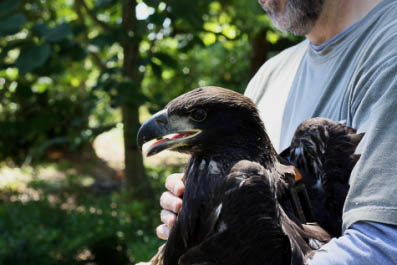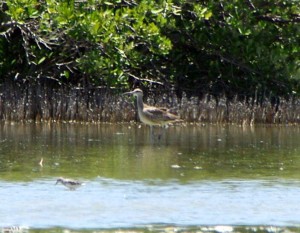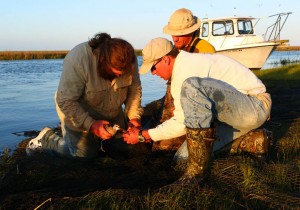Flight of Hope

Tracking Azalea
May 3, 2009Virginia Nest Locator Launched
May 5, 2009
Written by Bryan Watts
May 4, 2009

Hope fitted with satellite transmitter. Photo by Barry Truitt.
Hope, a whimbrel carrying a satellite transmitter, embarked on an incredible journey after being captured by the Center for Conservation Biology’s (CCB) researchers on Virginia’s Eastern Shore on May 19th, 2009. She left Virginia on May 26 and flew to the western shore of James Bay in Canada. She staged on James Bay for 3 weeks before flying to the MacKenzie River near Alaska and then on to the Beaufort Sea where she spent more than 2 weeks before flying back to Hudson Bay. Hope then staged on South Hampton Island in upper Hudson Bay for 3 weeks before leaving on a non-stop flight south on 10 August. The bird flew south over Hudson Bay, crossed the interior of Canada and New England to emerge from the coast of Maine and out over the open ocean. Flying more than 1,600 kilometers (1000 miles) out over the ocean and east of Bermuda, Hope then turned south, making landfall on St. Croix, U.S.V.I. on the evening of August 14.

Hope, spotted on August 21st, foraging on Great Pond, St. Croix, U. S. Virgin Islands in the Caribbean by Lisa Yntema. Photo by Lisa Yntema.
Hope was seen foraging on Great Pond in the U.S. Virgin Islands on August 20. Great Pond is a Birdlife International Important Bird Area on the island of St. Croix known for white-crowned pigeons, green-throated caribs, and Antillean crested hummingbirds. The site is a large pond fringed with black mangroves. Lisa Yntema has monitored the site for 5 years. She spotted and then photographed Hope. Hope is still in St. Croix, USVI, as of the recent satellite data from September 23rd.

Fletcher Smith (L), David Curtiss (C), and Adam Duerr (R), from the Center for Conservation Biology, extract a whimbrel named “Elkie” from rocket net on Elkins Marsh along the Eastern Shore. Photo by the Center for Conservation Biology.
Hope is one of several whimbrels that have been fitted with state of the art 9.5-gram, satellite transmitters in a collaborative effort by the Center for Conservation Biology at the College of William & Mary and Virginia Commonwealth University and the Virginia Chapter of The Nature Conservancy to discover migratory routes that connect the species’ breeding and winter areas and to identify en route migratory staging areas that are critical to the conservation of this declining species.
Satellite tracking represents only one facet of a broader, integrated investigation of whimbrel migration. Over the past 2 years, the Center for Conservation Biology, in partnership with The Nature Conservancy, has used conventional transmitters to examine stopover duration, conducted aerial surveys to estimate seasonal numbers, collected feather samples to locate summer and winter areas through stable-isotope analysis, and has initiated a whimbrel watch program. Continued research is planned to further link populations across staging, breeding, and wintering areas and to determine the ecological requirements of whimbrels staging along the peninsula.
Tracking map of Hope from 26 May through 14 August, 2009 – This female whimbrel has been tracked using a 9.5 gram, solar-powered satellite transmitter. Map by the Center for Conservation Biology.
Funding has been provided by The Nature Conservancy, the Center for Conservation Biology, The U.S. Fish and Wildlife Service, and the Virginia Coastal Zone Management Program.
Project sponsors:
The Center for Conservation Biology (CCB), the Virginia chapter of The Nature Conservancy (TNC) and the Virginia Coastal Zone Managment Program (CZM).



